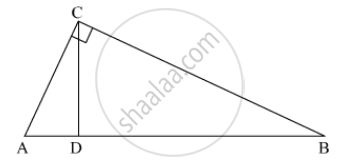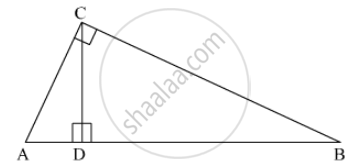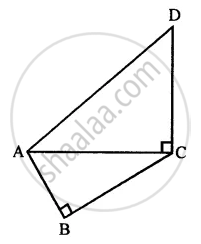Advertisements
Advertisements
प्रश्न
In Fig. 3, ∠ACB = 90° and CD ⊥ AB, prove that CD2 = BD x AD.

उत्तर

Given that :
CD ⊥ AB
∠ACB = 90°
To Prove : CD2 = BD x AD
Using Pythagoras Theorem in ΔACD
AC2 = AD2 + CD2 ....(1)
Using Pythagoras Theorem in ΔCDB
CB2 = BD2 + CD2 ....(2)
Similarly in ΔABC,
AB2 = AC2 + BC2 ....(3)
As AB = AD + DB
⇒AB = AD + BD ....(4)
Squaring both sides of equation (4), we get
(AB)2 = (AD+BD)2
⇒AB2 = AD2 + BD2 + 2 x BD x AD
From equation (3) we get
⇒ AC2 + BC2 = AD2 + BD2 + 2 x BD x AD
Substituting the value of AC2 from equation (1) and the value of BC2 from eqution (2), we get
AD2 + CD2 + BD2 + CD2 = AD2 + BD2 + 2 x BD x AD
⇒ 2 CD2 = 2 x BD x AD
⇒ CD2 = BD x AD
Hence Proved.
संबंधित प्रश्न
If the sides of a triangle are 6 cm, 8 cm and 10 cm, respectively, then determine whether the triangle is a right angle triangle or not.
The diagonal of a rectangular field is 16 metres more than the shorter side. If the longer side is 14 metres more than the shorter side, then find the lengths of the sides of the field.
In the given figure, angle ACB = 90° = angle ACD. If AB = 10 m, BC = 6 cm and AD = 17 cm, find :
(i) AC
(ii) CD

In the given figure, AD = 13 cm, BC = 12 cm, AB = 3 cm and angle ACD = angle ABC = 90°. Find the length of DC.

In an equilateral triangle ABC, the side BC is trisected at D. Prove that 9 AD2 = 7 AB2.
From given figure, In ∆ABC, If AC = 12 cm. then AB =?

Activity: From given figure, In ∆ABC, ∠ABC = 90°, ∠ACB = 30°
∴ ∠BAC = `square`
∴ ∆ABC is 30° – 60° – 90° triangle
∴ In ∆ABC by property of 30° – 60° – 90° triangle.
∴ AB = `1/2` AC and `square` = `sqrt(3)/2` AC
∴ `square` = `1/2 xx 12` and BC = `sqrt(3)/2 xx 12`
∴ `square` = 6 and BC = `6sqrt(3)`
A 5 m long ladder is placed leaning towards a vertical wall such that it reaches the wall at a point 4 m high. If the foot of the ladder is moved 1.6 m towards the wall, then find the distance by which the top of the ladder would slide upwards on the wall.
In a right-angled triangle ABC, if angle B = 90°, BC = 3 cm and AC = 5 cm, then the length of side AB is ______.
Two squares having same perimeter are congruent.
The foot of a ladder is 6 m away from its wall and its top reaches a window 8 m above the ground. Find the length of the ladder.
